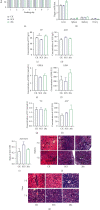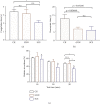A Traditional Chinese Medicine for the Treatment of Endometrial Hyperplasia via Regulating the HPO Axis in Rats
- PMID: 35154346
- PMCID: PMC8828340
- DOI: 10.1155/2022/5200608
A Traditional Chinese Medicine for the Treatment of Endometrial Hyperplasia via Regulating the HPO Axis in Rats
Abstract
Dysfunctional uterine bleeding, accompanied by endometrial hyperplasia (EH), is a common gynecological disease that seriously affects female physical and mental health. Some drugs have been prompted to cure the disease, but most medications have certain side effects and limitations. In the present study, we demonstrated an unexploited Chinese traditional medicine, a combination of Saururus chinensis, Celosia cristata, and Spatholobus suberectus (SCS), which could be used for the treatment of EH and associated complications in rats. We identified the active components from the three Chinese herbs via thin-layer chromatography and high-performance liquid chromatography methods. In addition, serum biochemical indexes and histologic section results found that acute high-dose SCS exerted no adverse impacts on the rats. We then showed that SCS shortened coagulation time (p=0.018) and degree of swelling (p=0.021) on rats at 30 min compared to blank control. Further studies proved that recovered endometrial thickness was associated with the modulation of four hormones (follicle-stimulating hormone, luteinizing hormone, estrogen, and progesterone). Specifically, follicle-stimulating hormone and progesterone contents increased gradually with time, and estrogen was decreased, whereas luteinizing hormone content was returned to normal after a short-term elevation (p < 0.05). Besides, SCS increased uterine endometrium's mRNA expression levels of matrix metalloproteinase-1 (p < 0.001) and tissue inhibitor of matrix metalloproteinase-1 (p < 0.001), promoting the repair of proliferating endometrium in the rats. Collectively, our study indicates that SCS harbors a profoundly curative effect on the treatment of EH and relative complications and uncovers the mechanism at molecular and gene expression levels.
Copyright © 2022 Bo Lv et al.
Conflict of interest statement
The authors declare that they have no conflicts of interest.
Figures








Similar articles
-
Hormone serum levels and hormone receptor contents of endometria in women with normal menstrual cycles and patients bearing endometrial carcinoma.Gynecol Obstet Invest. 1979;10(2-3):71-80. doi: 10.1159/000299920. Gynecol Obstet Invest. 1979. PMID: 535775
-
Effect of clomiphene citrate treatment on endometrial estrogen and progesterone receptor induction in women.Am J Obstet Gynecol. 1991 Jul;165(1):177-85. doi: 10.1016/0002-9378(91)90247-o. Am J Obstet Gynecol. 1991. PMID: 1906682
-
Endometrial patterns in women on chronic luteinizing hormone-releasing hormone agonist treatment for contraception.Fertil Steril. 1981 Sep;36(3):339-42. doi: 10.1016/s0015-0282(16)45735-3. Fertil Steril. 1981. PMID: 6793403
-
Effects of hormone therapy on the endometrium.Mod Pathol. 1993 Jan;6(1):94-106. Mod Pathol. 1993. PMID: 8426860 Review.
-
The effects of steroids on the fine structure of the endometrium.Baillieres Clin Obstet Gynaecol. 1989 Jun;3(2):227-48. doi: 10.1016/s0950-3552(89)80020-3. Baillieres Clin Obstet Gynaecol. 1989. PMID: 2692919 Review.
Cited by
-
Network Pharmacology and Molecular Docking Approach to Reveal the Immunotherapeutic Mechanism of Cuscutae Semen in Treating Thin Endometrium.J Immunol Res. 2022 Sep 22;2022:4333128. doi: 10.1155/2022/4333128. eCollection 2022. J Immunol Res. 2022. PMID: 36249421 Free PMC article.
-
Processed Polygonatum cyrtonema Hua attenuates postpartum depression in rat model by regulating monoamines and hormones.Heliyon. 2024 Mar 1;10(5):e26895. doi: 10.1016/j.heliyon.2024.e26895. eCollection 2024 Mar 15. Heliyon. 2024. PMID: 38449668 Free PMC article.
References
LinkOut - more resources
Full Text Sources

